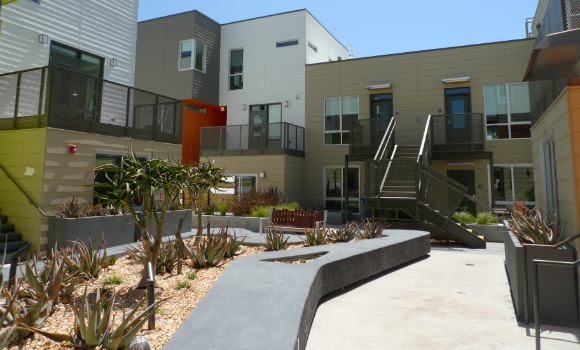
A new study breaks down the cost of building affordable housing in California, and the good news is it can be built more cost-effectively and the benefits are plentiful.
It’s well-known Californians spend an increasing percentage of income on housing, as median rent from 2000 to 2012 went up 20 percent in the state while median income dropped by eight. That’s a huge issue if you want a skilled workforce at all income levels to be available for employers.
Compiled by four state agencies, the study cites a rainbow of benefits from research showing affordable housing’s effect on education performance, economic stimulation, public health and the reduction of reliance on social services. The list is a regular Who’s Who from the principles of the Triple Bottom Line concept (jobs, environment, community equity).
Bolstering the affordable housing stock should make any region more competitive, says the study authors, as housing helps employers more easily attract and keep employees. And more construction jobs created by affordable housing projects can’t hurt, after jobs in that sector in California dropped by around 40 percent during the Great Recession.
As to what drives up cost of affordable housing construction in California, it’s not any one thing, says the study. Of course, using higher quality materials to ensure a long-lasting structure drives up the cost per unit. But also building underground or podium parking adds six percent to these types of projects, the authors estimate. Satisfying local requirements for affordable housing projects will typically add five percent, as projects face multiple hearings to work through local opposition. And using funding from local redevelopment initiatives can add seven percent to affordable housing projects for various reasons.
And the cost of land will have other interesting effects on affordable projects, such as the type of building built. For instance, the study notes the higher the land cost, the more likely the project will be high density and taller, which also adds the the building construction costs.
Certainly for cities and regions looking at all of these factors, streamlining costly pain points during construction could help with the problem. But also, the study found that projects by some developers cost less than projects by other developers, after controlling for variables like building quality. The takeaway there is a good reminder to use data to drive decisions, like most people when buying a car, and find the best quality-to-cost ratio among developers.
While here’s been some action in the Legislature and in the budget created to build more affordable housing here, advocates, including the Summit’s Housing Action Team continue to call for a permanent source of funding for such projects. The signing of the Enhanced Infrastructure Financing District bill and this year’s cap-and-trade deal should bring cities more opportunities for local construction projects.
Looking over the study’s list of costs and benefits, it’s good to know, as that permanent funding is sought after, there are indentifiable ways to build better and more cost effectively. Also, affordable housing can look pretty spiffy these days, which can help with that local opposition.
A while back we shared this infographic showing California’s affordable housing conundrum in two charts. Let’s take another look:

